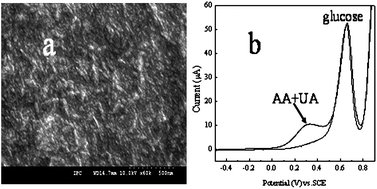Non-enzymatic glucose detection using as-prepared boron-doped diamond thin-film electrodes
Abstract
Electrochemical

* Corresponding authors
a
College of Chemistry and Chemical Engineering, Jishou University, Jishou, Hunan Province, P. R. China
E-mail:
zhjw76@hotmail.com
Fax: +86 743 8563 911
Tel: +86 743 8563 911
b
Laboratory of Organic Optoelectronic Functional Materials and Molecular Engineering, Technical Institute of Physics and Chemistry & Graduate University of Chinese Academy of Sciences, No.2, Beiyitiao, Zhong-guan-cun, Haidian District, Beijing, P. R. China
E-mail:
zhi-mail@mail.ipc.ac.cn
Electrochemical

 Please wait while we load your content...
Something went wrong. Try again?
Please wait while we load your content...
Something went wrong. Try again?
J. Zhao, L. Wu and J. Zhi, Analyst, 2009, 134, 794 DOI: 10.1039/B819303G
To request permission to reproduce material from this article, please go to the Copyright Clearance Center request page.
If you are an author contributing to an RSC publication, you do not need to request permission provided correct acknowledgement is given.
If you are the author of this article, you do not need to request permission to reproduce figures and diagrams provided correct acknowledgement is given. If you want to reproduce the whole article in a third-party publication (excluding your thesis/dissertation for which permission is not required) please go to the Copyright Clearance Center request page.
Read more about how to correctly acknowledge RSC content.
 Fetching data from CrossRef.
Fetching data from CrossRef.
This may take some time to load.
Loading related content
